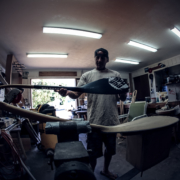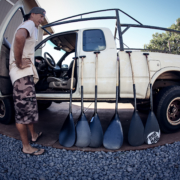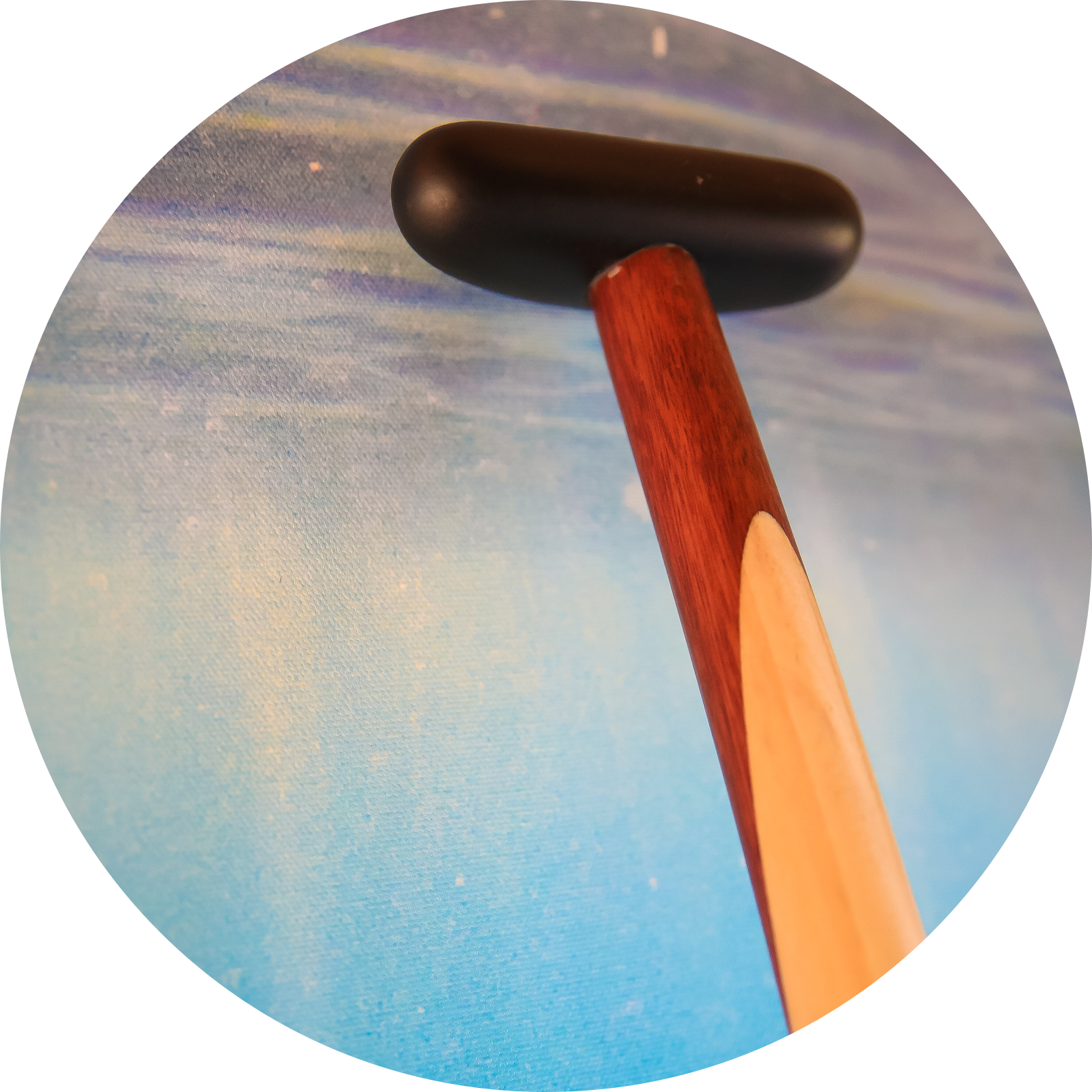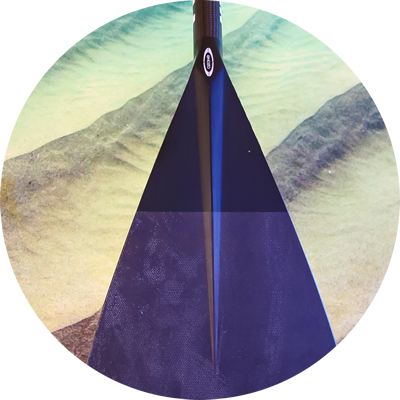Introducing: Palafamala Paddles
Designed on Maui,
Built by Ozone
The paddle is a natural partner to a canoe, so we decided to explore adding a paddle line to our product offering. After some years dabbling in paddle design, a relationship with a Maui-based paddler designer developed. Cameron Jacome (Ja-co-me pronounced Ha-Koh-Meh) has been building handcrafted paddles in Lahaina for almost 20 years and committed to it full time about a decade ago. His work is impressive and his journey even more so.
We appreciated his passion for paddling and commitment to quality, which resonates deeply with Mike Giblin and the path in building Ozone. Mike and our Production Manager Brian learned every step of the paddle shaping process from Cameron, taking his techniques and applying them to Ozone’s construction, tools, and methods. The goal was to build a paddle with the craftsmanship and quality expected of Palafamala, at scale to reach more paddling communities. Below you will learn about the process and approach to create a paddle that both Ozone and Palafamala are proud to offer the paddling community around the globe.

Naim: Cameron, I would like to get a bit of back-story to explain to paddlers about the Palafamala and Ozone relationship and how it all got started.
Cameron: Most people who know the paddle also know that they have to wait a year and a half before they can get one. This is where Michael Giblin and Team Ozone come to the rescue.
I always had a connection with my paddles before I started making my own. If it wasn’t made by one of the Keahi’s than it was made by Malama Chun who makes beautiful flawless all wood paddles here on Maui. I was always so proud to use either one. It was the feeling of representing the paddle maker that gave me the connection and the love for the blade. I know that it’s not that easy to stay connected when paddles are mass-produced and distributed worldwide but my goal would be to have everyone connected to the feeling of the Palafamala story and the people who helped create it. Brian Dalbey is now an extension of this feeling and is making these in his workshop. Without this connection, it would just be another paddle on the market with degrees and dimensions.
Naim: One of my first paddles was a Malama, and I cheerished it, so I agree with everything you are saying. There is more than meets the eye when it comes to the weapons of choice. Which begs the question; is the Palafamala the secret weapon that every paddler is looking for?
Cameron: I have paddled long enough and talked with paddlers long enough to know that everyone doesn’t like the same thing. It is impossible to make one paddle that has everything for everyone. Paddlers have too many differences. I listen to everyone and try out their ideas. Some have been very helpful. In the end, I make what I like and what I think the majority will like. So far it’s been pretty good.
Naim: Can you tell us about the shape of the the Blade? How was it developed?

Cameron inspects the Ozone Built paddle, after months of working closely with Brian to perfect the blade
Cameron: The shape of the blade came from my freind Kekai Keahi. It was him and his family that taught me how to make paddles. We had all kinds of different shapes but I really liked this one so it’s the one that I stuck with. It was his latest design and one that he came up with after we went to Tahiti for Hawaiki Nui in 2005.
I started out making my paddles with a flat back. If you see my earlier edition paddles around they will all have flat backs. About 2 years ago I changed the back to have a very slight scoop. It is called a 15-degree radius. If you take a circle with a 30’ diameter and then cut an 18” section off of the perimeter you will have the scoop in the blade. This scoop was added to get even more bite.
Naim: We always hear about the ‘bite’ of a paddle, and in my years of paddling I have taught or been taught to get a good bite. What is your phylosophy when it comes to the catch, or bite of the blade and how does the Palafamala compare?
Cameron: We all know that the bite/catch is the most important part of the stroke. It is your anchor and it allows you to lock in without slipping. You should choose the blade size that gives you the truth, meaning that the blade should never come backwards and the canoe should always go forwards.
I would recommend using the smallest blade possible while still being able to maintain an honest bite. This way you will be able to bring your blade closer to the canoe allowing yourself to walk over the blade with better leverage.
Some people might need a bigger blade to stay honest and others might need a smaller blade if an honest bite is too much to handle. A lot of choices can also just be personal preference for what fits your paddling style. For me it’s all about the feeling and holding onto the pressure/resistance.
Naim: What about technique and paddle size etc? Can you tell us about the sizes and how to choose the correct size?
Cameron: Generally, paddlers with a slower stroke will use a blade with more resistance(bigger) and paddlers with a faster stroke will use a blade with less resistance(smaller). As for OC6 most will use a bigger blade than they do in OC1 due to having more weight to pull forward.

These are some of the paddles built by Brian prior to arriving at the final version ready for production
I try to stay away from recommending a blade size for anyone in an OC6. If they are using for OC6 then that means that they are in a club. Clubs have coaches and coaches usually know what they want for their paddlers. Length and blade size depends on the technique that they are teaching as well as the strength and ability of their paddlers. If their coach isn’t available for sizing then I will give my recommendation. This is where you will need to know your community best and learn what people in your area are using. As I’m sure you already know, you will find that the theories are all over the place. That’s why paddling is so awesome. There isn’t one answer for all. It’s an endless search that continues to revolve.
Naim: What are the different blade sizes and options?
Cameron: We currently have 3 blade options, which are 9.25, 9.5, and 9.75. This is measured horizontally at the widest point of the teardrop. All of these blades are 18” long. Our 9.5 is by far the most popular.
Right now I’m working with Brian to add a smaller blade to the lineup. It will be around 9 inches wide and 17 inches tall. I made this blade before, but it wasn’t that popular in Hawaiian waters. I definitely feel that there is a need for it in more calm waters around the world. We hope to have this available soon.
Naim: Since we’re talking about development, what else do you have in store? I know you are a steersman, and I have seen some of your custom steering blades. Will a steering blade be an option at some point?
Cameron: Yes, I can’t wait. I need one myself. I always give mine to someone who is desperate and then end up without one.
Brian and I are in the process of making my original steering blade. It is 9.25 inches wide and 21.5 inches long. The blade width is narrow which allows you to paddle with less fatigue and the blade length is long to be able to keep control while screaming down a wave.
It has a strong backbone that allows the blade to stick to the side of the canoe. It also has high shoulders for better control and strength when needed.
We will be making the traditional 5 degree straight shaft steer for what the majority is using now but we are also making a double bend steer. I wasn’t sold on these right away. I thought it was something trendy and didn’t care to try it. Finally, after so many people asked for them, I decided to make one for myself. I put the blade at 7 degrees to get a better blend with the crew and I loved it! The double bend made me feel like a 6th paddler. Now I’m addicted.
Both of these blades are good for all around paddling. They will bang turns in a regatta and hold on in big water. I prefer the double bend in anything that is anywhere near flat. There is definitely room for a smaller steer in the quiver for those very experienced flat water steersman but we are going to just focus on these for now.

Carbon Pre-Preg: Single-piece handle is durable and lightweight
Western Cedar: Adds contrast and beauty
Sitka Spruce with Poplar Stringer: The Spruce is lightweight and makes up the majority of the shaft material. The Poplar stringer and Spruce combination provides ideal strength and flex.

Ozone Water Transfer Logo
Dihedral
15-degree radius scoop

Carbon Pre-Preg Handle
Western Cedar
Sitka Spruce with Poplar Stringer
Carbon Sleeve
3 blade options are 9.25, 9.5, and 9.75 inch wide, 18 inch length. With a 4th option coming soon (around 9×17 inch)
Palafamala represents the family and friends that have been part of the growth, learning and paddling lifestyle unique in Mala.
The blade options are 9.25, 9.5, and 9.75. This is measured horizontally at the widest point of the teardrop. Soon we will have a 4th smaller option at 9×17 for those looking for event less resistance in the catch.
Poplar and Basswood have been the standard shaft materials for years but we searched for something better. After many different woods and layups we ended up using Poplar for the stringer and Vertical Grain Sitka Spruce for the sides. We found this to be the best for weight, strength and flex.
The darker wood on the upper part of the shaft is Western Red Cedar. We use it to add contrasts and beauty while maintaining good weight.
The carbon sleeve in the shaft is not needed for strength. The shaft alone is strong enough. The carbon helps the shaft from getting dings or wear from rings etc. Some paddlers look at carbon and instantly think it’s going to be too stiff but realistically there is plenty flex.
I made my T tops to be comfortable. I used to hand shape all of these using Cedar for the beauty and the lightweight. It ended up being too soft and would dent easily. I moved on to Basswood that was harder and painted it black since there was no pretty grain. It still wasn’t as durable as I would like. Michael Giblin took my design and made a super light, durable, carbon T top. I am super happy with it.
Naim: It’s been great working with you, and we all can see how dedicated you are to the craft, customers and the paddling way of life. Can you tell us about the fish on the logo? The first time I picked up one of your blades, I was wondering what a fish had to do with a paddle, can you explain?
Cameron:  You will hear more about the meaning of Palafamala and what it means to me by watching “The Story Behind Palafamala” video (below), but for the basics, the fish on the logo is the actual Pala. Really it’s a dark brown fish that is smaller than the logo and it’s good to pan fry. It is best when caught at the family grounds of Mala.
You will hear more about the meaning of Palafamala and what it means to me by watching “The Story Behind Palafamala” video (below), but for the basics, the fish on the logo is the actual Pala. Really it’s a dark brown fish that is smaller than the logo and it’s good to pan fry. It is best when caught at the family grounds of Mala.
This logo represents the family and friends that I was so fortunate to live, learn, and laugh with while beginning my paddling life.
Naim: Awesome! Well, it is so good to see your work grow and flourish. I am so happy with how the video came out to share the story of how Palafamala came to be. I was moved by the aloha spirit shared by the Keahi ohana.
How can people reach you with questions or orders?
Cameron: Yeah, I’m stoked you liked the vid. It really means a lot to me and the families involved. These are the people that deserve all of the credit. You can contact me on my website Palafamala.com or give me a call at (808)357-2264
Aloha,
Cameron Jacome
Owner/Shaper
A video sharing the background of the paddle shaper and the family that shaped a paddler
 Outrigger Zone
Outrigger Zone  Chattajack Ozone at Chattajack
Chattajack Ozone at Chattajack